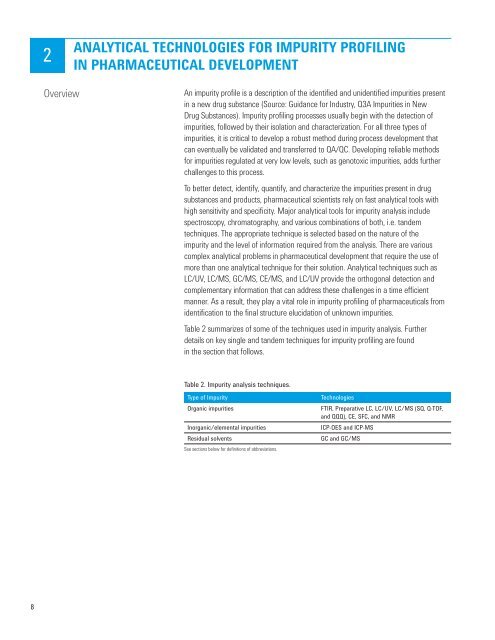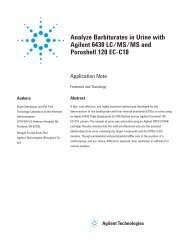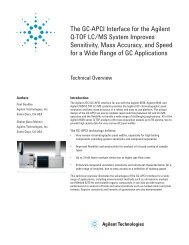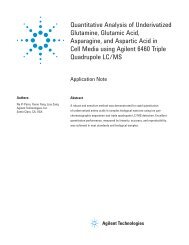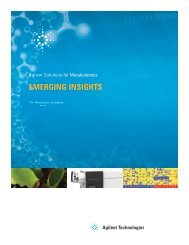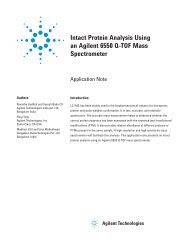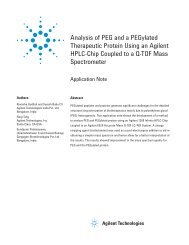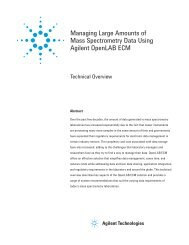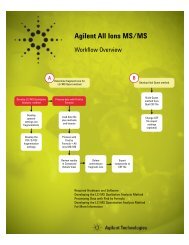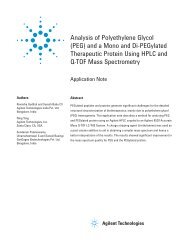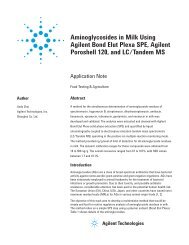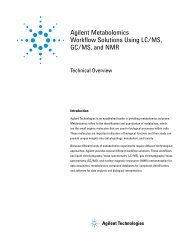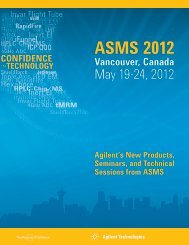pharmaceutical impurity analysis solutions - Lcms-connect.com
pharmaceutical impurity analysis solutions - Lcms-connect.com
pharmaceutical impurity analysis solutions - Lcms-connect.com
Create successful ePaper yourself
Turn your PDF publications into a flip-book with our unique Google optimized e-Paper software.
2ANALYTICAL TECHNOLOGIES FOR IMPURITY PROFILINGIN PHARMACEUTICAL DEVELOPMENTOverviewAn <strong>impurity</strong> profi le is a description of the identifi ed and unidentifi ed impurities presentin a new drug substance (Source: Guidance for Industry, Q3A Impurities in NewDrug Substances). Impurity profi ling processes usually begin with the detection ofimpurities, followed by their isolation and characterization. For all three types ofimpurities, it is critical to develop a robust method during process development thatcan eventually be validated and transferred to QA/QC. Developing reliable methodsfor impurities regulated at very low levels, such as genotoxic impurities, adds furtherchallenges to this process.To better detect, identify, quantify, and characterize the impurities present in drugsubstances and products, <strong>pharmaceutical</strong> scientists rely on fast analytical tools withhigh sensitivity and specifi city. Major analytical tools for <strong>impurity</strong> <strong>analysis</strong> includespectroscopy, chromatography, and various <strong>com</strong>binations of both, i.e. tandemtechniques. The appropriate technique is selected based on the nature of the<strong>impurity</strong> and the level of information required from the <strong>analysis</strong>. There are various<strong>com</strong>plex analytical problems in <strong>pharmaceutical</strong> development that require the use ofmore than one analytical technique for their solution. Analytical techniques such asLC/UV, LC/MS, GC/MS, CE/MS, and LC/UV provide the orthogonal detection and<strong>com</strong>plementary information that can address these challenges in a time effi cientmanner. As a result, they play a vital role in <strong>impurity</strong> profi ling of <strong>pharmaceutical</strong>s fromidentifi cation to the fi nal structure elucidation of unknown impurities.Table 2 summarizes of some of the techniques used in <strong>impurity</strong> <strong>analysis</strong>. Furtherdetails on key single and tandem techniques for <strong>impurity</strong> profi ling are foundin the section that follows.Table 2. Impurity <strong>analysis</strong> techniques.Type of ImpurityOrganic impuritiesInorganic/elemental impuritiesResidual solventsSee sections below for defi nitions of abbreviations.TechnologiesFTIR, Preparative LC, LC/UV, LC/MS (SQ, Q-TOF,and QQQ), CE, SFC, and NMRICP-OES and ICP-MSGC and GC/MS8


